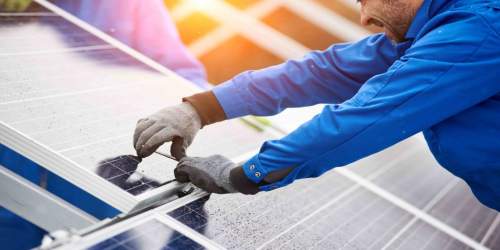Read Time : 5 Minutes
The Smart Export Gurantee
The Smart Export Guarantee also known as (SEG) is the Government’s replacement for the earlier Feed in Tariff or (FIT). The scheme rewards eligible renewable energy providers with cash for all the energy they can export to the grid. It was introduced to replace the Feed-in Tariff (FIT) scheme, which closed to new applications in March 2019.
The energy sector has been going through a very turbulent phase. Spiralling gas costs are causing considerable financial difficulties for thousands of households. The rising costs have also led to 30 of the mostly smaller energy companies going bust. The recent spate of closures is evidence of the depth of the current crisis in the energy market. The energy regulator, Ofgem has provided a safety net for millions of customers, maintaining energy supplies to domestic customers, and protecting their credit balances while moving their accounts to a new supplier.
At the same time electricity supplies are threatened due to most of the UK’s ageing nuclear reactors, which provide 20% of the UK’s electricity, being closed in the next few years. On top of this the UK is facing a dilemma if it is to succeed in reaching net zero carbon emissions by 2050. We need to reduce our reliance on the use of fossil fuels radically in order to keep to this target while growing our renewable energy industry to be able to meet our power demands in the future.
COMPARE PRICES FROM LOCAL INSTALLERS
Compare prices from local companies fast & free
Enter your postcode to compare quotes from leading professionals. We promise to keep your information Safe & Secure. Privacy Policy
Approximately half our electricity is generated by burning natural gas in power plants. About half of that comes to our shores from North Sea rigs whose overall output is dwindling as gas fields reach the end of their lives. The rest of our gas is imported from other nations; most of it is shipped from Qatar or the US or piped from Norway.
Despite all this many of the energy suppliers that have survived are still providing the Smart Export Guarantee. The pandemic, Covid-19 does not appear to have had an adverse effect on the SEG. If anything, the demand for the SEG has risen during the crisis.
Without doubt, energy security and fighting climate change are inextricably linked.
Am I eligible for the Smart Export Guarantee?
To qualify, you need to meet specific requirements. First, only low-carbon energy counts, so any energy you produce must meet this condition. Most renewable energies count and include solar photovoltaic (PV), onshore wind, hydro, micro combined heat and power (MICRO-CHP), and anaerobic digestion (AD). In addition, your system must have a total installed capacity (TIC) of under 5MW and can only generate up to 50kW in power.
In order to be eligible for the SEG there are 3 key requirements for all households:
- You must be located in the UK
- You need to be generating renewable energy at home via solar PV, wind, hydro, micro combined heat, and power (CHP), or anaerobic digestion (AD), with a maximum capacity of 5 megawatts.
- Your installation must be MCS certified. The Microgeneration Certification Scheme (MCS) certifies, quality assures and provides consumer protection for microgeneration installations and installers.
- Have the ability to opt out of FiT payments. or be prepared to lose your FiT export payment if you move to SEG.
- Not be receiving SEG payments from another licensee.
The next step is to sign up to a SEG tariff with an energy supplier so that you can receive payments for your excess electricity.
You will also usually need to get a smart meter installed which will allow for more accurate readings of the electricity you are exporting to the grid. The smart meter can make a recording of your electricity exports on a half-hourly basis and communicate directly with your energy supplier enabling them to pay exactly what they owe you. Fortunately, the UK government is currently carrying out a nationwide rollout of smart meters for free. The SMETS1 smart meter was incompatible with solar panels, but the second-generation SMETS2 is compatible, and any UK household is entitled to a free model before the end of 2025.
What happens if I qualify for the Smart Export Guarantee?
If you’re eligible, energy companies can offer you a license to export your excess power back to the national grid. All energy providers with over 150,000 UK customers have the mandatory right to grant licenses. Smaller firms with lower customer numbers can also apply to issue licenses on a voluntary basis.
There are two different ways that you can be paid by suppliers for your excess electricity, either a fixed rate or a flexible rate.
- Under the SEG, a fixed rate is a set amount of money for each kWh of renewable electricity you export to the grid, irrespective of the time of day.
- A flexible rate SEG pays different amounts of money depending on the time of day. By way of example, you might be paid more for the electricity you export in the evening when there is a higher demand for electricity and less in the morning.
Eventually, the Department for Business, Energy and Industrial Strategy (BEIS) would like all fixed rate tariffs to be replaced by flexible rate tariffs, which go up and down every half hour based on wholesale electricity market prices.
The exact amount you receive for the electricity you export depends on your energy supplier.
How do I apply for the Smart Export Guarantee?
To apply for the SEG you need to contact your energy provider or, an energy provider that offers the SEG to non energy customers.
You will need:
- A valid MCS or Flexi-Orb certificate. This will be provided by an MCS certified installer only.
- Proof of your address and ownership of your property
- A photograph of your export or smart meter
- If you have a battery, a schematic diagram of your system
- District Network Operator (NDO) approval acceptance letter or email
- If you're in Scotland, then a G98 or G99 approval form
If you're applying for a business and you pay VAT, then you will need to include this on your application form and declare any VAT.
How much can I earn from the Smart Export Guarantee?
How much money you make depends on how many units you sell and the tariff you’re on. Each supplier offers different rates and shopping around for the best deal is always the smartest plan. Some companies offer better rates for fixed contracts, while others offer higher prices if you take other services like gas.
In the energy sector rates shift with some frequency in the volatile market, but as far as we could gather, as of October 2023, here are the best rates at present:
- Octopus Energy (24p or 15p per kWh with special deals)
- Scottish Power (15p or 12p per kWh with special tariffs)
- British Gas (6.4p per kWh)
- EDF Energy (5.6p per kWh)
- E:On (5.5p per kWh)
- Positive Energy (5p per kWh)
- So Energy (5p per kWh)
- OVO Energy (4p per kWh)
- Shell Energy (3.5p per kWh)
- Utility Warehouse (2p per kWh)
Please remember there may be some small print attached to the prices above like fixed-term contracts or additional service clauses. It’s always a good idea to do your own research.
What effects the amount you get paid from the SEG?
- how much electricity your solar panels can generate
- how much electricity you send to the grid
- how much you pay for grid electricity
- what SEG rate you receive
If you have invested in a solar-plus-battery system at home, you will need to find out whether your energy supplier will accept solar energy exported from a battery. Not all energy companies do, and some don’t make it clear online whether they do or not. Bulb, Octopus Energy and British Gas do offer this service but it’s as well to check with your energy company what their policy is about solar batteries.
When did the Smart Export Guarantee come into effect?
SEG is the Government’s replacement for its popular Feed in Tariff (FIT). Applications for FIT closed on the 31st of March 2019, but some contracts are still running. The Smart Export Guarantee came into force a little under a year later on the 1st of January 2020. As discussed, because of the terms of some Feed in Tariff contracts, there are still some households with the provision.
What’s the difference between the Smart Export Guarantee and the Feed in Tariff?
While the two incentives are similar, the newer Smart Export Guarantee has one significant drawback. In the heady days of the solar gold rush, the Government offered lofty subsidies. These programs tried to nudge the public into putting up solar panels. Amongst them was the Feed in Tariff (FIT). FIT promised to pay eligible small-scale energy providers for both the energy they exported and a lump sum for ALL the energy they produced. Obviously, paying folks to generate their own power was unsustainable. This is why they replaced the scheme with the Smart Export Guarantee.
Unlike FIT, SEG only pays local generators for the energy they provide to the national grid. SEG contracts, therefore, offer nothing for the overall power produced. As you can imagine, FIT was a good deal more lucrative than its successor and you’ll often hear folks rant about the good old days. The truth is though, the Smart Export Guarantee is still a worthwhile program and can turn any renewable energy installation into a decent investment.
In conclusion
While it's no Feed in Tariff, the Smart Export Guarantee is still a strong incentive to move towards renewable energy. While some variants are more complicated than others, in particular Anaerobic Digestion (AD), the application process is simple enough. Securing a decent tariff from your supplier can make a big difference in your return on investment. This can be the key to making SEG work for you but be careful not to tie yourself to one fence for too long as the market is ever shifting.
With electricity prices rising exponentially it is important to make savings wherever you can. Now is a very good time to look at ways you can reduce your energy bills and solar panels are well worth the investment.
Find a local installer
Welcome to the biggest directory of UK renewable energy companies





 How Much do Solar Panel Systems Cost in 2024?
How Much do Solar Panel Systems Cost in 2024?







